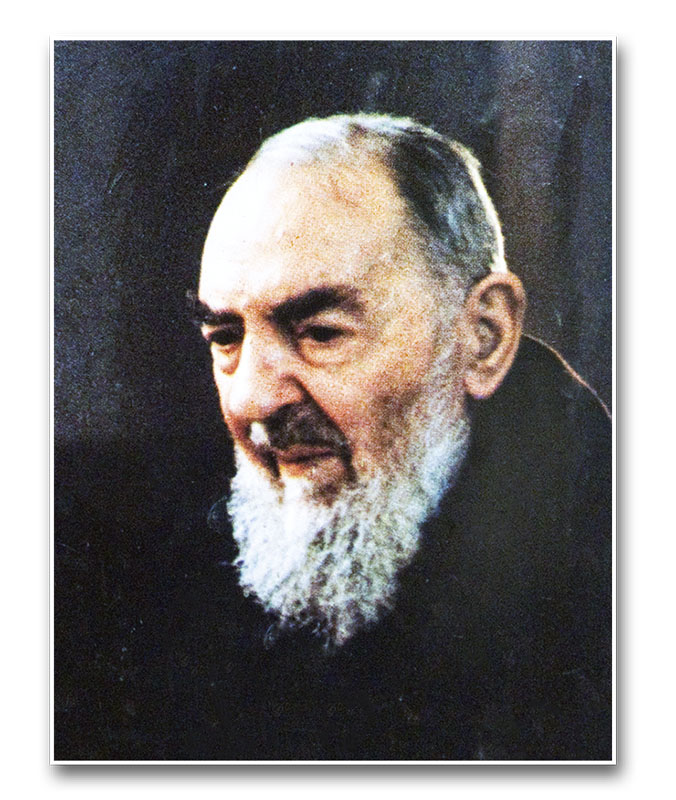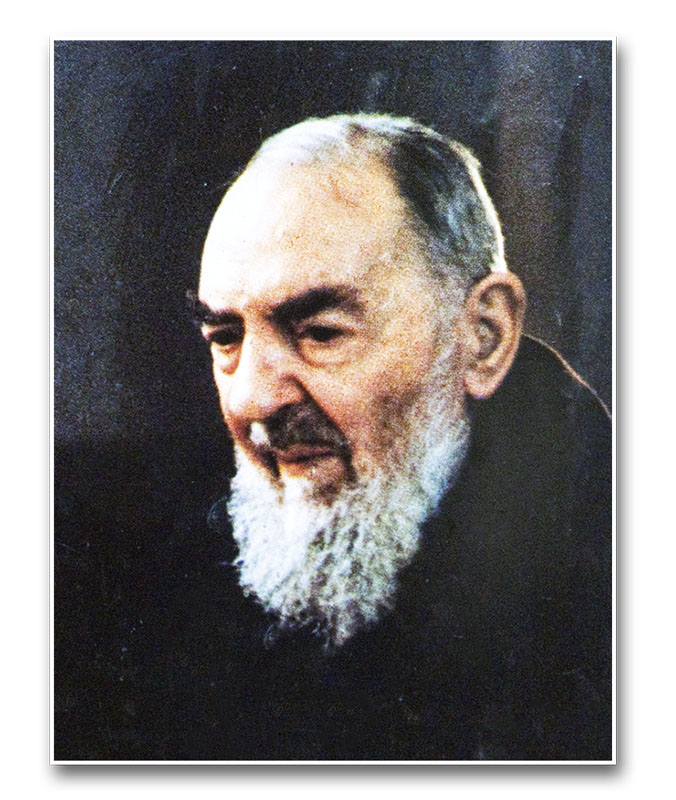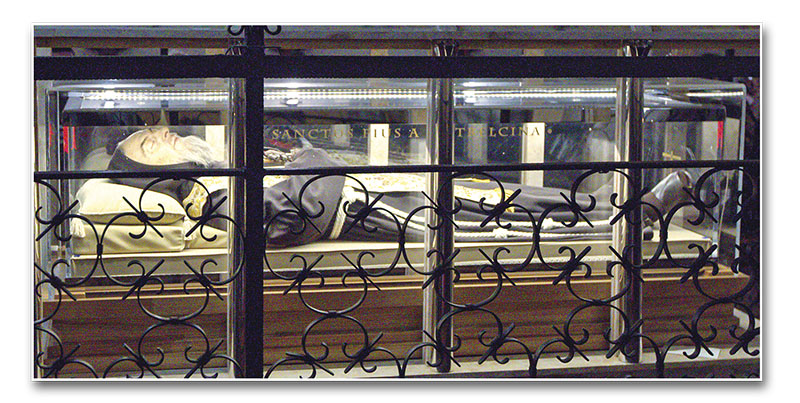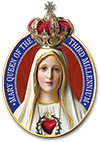
St. Pio of Pietrelcina – Cross, Persecution and Glory

The sufferings caused by his stigmata, the almost superhuman efforts involved in his fruitful pastoral work and the calumnies and persecutions he suffered have made Padre Pio one of today’s most revered Saints.
In the centre of the Campania region, a few kilometres from the commune of Benevento, lies the small agricultural town of Pietrelcina. There, in a simple house having only a few rooms, lived the family of Grazio Forgione and Maria Giuseppa Di Nunzio. On May 25, 1887, a boy was born to them, and received the name Francesco.
A religious vocation at an early age
Little Francesco liked to pray and often served as an altar boy in the parish. At an early age, he expressed to his parents his desire to be a Capuchin friar, and they raised no objection. In fact, Grazio began to work far from home in order to earn enough for his son to be able to study. His wife, for her part, “a woman of the people, but with the qualities of a true lady,” prayed for him assiduously.
At the age of five, the boy began to be favoured with mystical phenomena, such as ecstasies and apparitions, but he revealed them to no one until his adulthood. Among other reasons, he imagined that they were something ordinary, which could happen to anyone. Although he was in many ways a typical child, he did not always want to play with the other boys his age, because many of them uttered blasphemies or indecencies, and he never used foul language.
In January 1903, even before his sixteenth birthday, he entered as a novice in the monastery of Morcone, receiving the name Brother Pio of Pietrelcina. At the moment of his leave-taking, Maria Giuseppa said to him: “My son, my heart is broken. But do not think now of your mother’s sorrow; if St. Francis called you, go in peace.”
“The devil wants me for himself”
His solemn profession took place on January 27, 1907. However, in May, a mysterious sickness forced him to return to Pietrelcina, as doctors believed that his native air would cure him. This time of illness, during which he suffered severe spiritual torments, would last for almost seven years. The devil wanted to snatch him from the hands of Jesus, while he burned with the desire to be a priest.
On August 10, 1910, he was ordained at the Cathedral of Benevento. However, due to his state of health, he continued to live with his family most of the time, assisting the parish priest in the pastoral duties of the town. At that time he suffered tremendous diabolical attacks, of which he commented: “The devil wants me for himself at all costs.”
His spiritual director, Fr. Agostino from San Marco, reports that when he asked him about the events of those years, St. Pio said: “I cannot reveal why the Lord wanted me in Pietrelcina, It would be against charity…” A mysterious answer, as yet not interpreted…
Confessor with extraordinary charisms
In 1916, he finally returned to community life, this time in the monastery of San Giovanni Rotondo. It was not long before countless souls in need of spiritual guidance began to seek out the new friar whose foremost counsel was clear and simple: frequent Communion and Confession.
The heavenly visions of his childhood returned and became habitual. He would recount them to his spiritual directors, saying quite simply, “Our Lord appeared unto me…” or “Jesus came and said to me…”
Favoured with the gift of discernment of spirits, he saw what was happening deep within souls and consciences. As a result, the queues at his confessional became so long that it was necessary to distribute numbers to organize them. He also possessed the infused knowledge of foreign languages and the gift of bilocation, among many other extraordinary charisms.
His daily routine consisted of praying, reading, and especially hearing Confessions. The penitents who received the Sacrament of Reconciliation through him recovered their peace, and his Masses drew great numbers. It was said that “whoever sees him celebrate once never forgets it.”
However, he would always declare with total humility: “I know very well that there is nothing in me that would be able attract the attention of this most sweet Jesus. Only His good will has lavished so many goods upon my soul.”
A painful Calvary begins
In 1918, like St. Teresa of Jesus, he received the grace of transverberation. On August 5, Padre Pio relates in a letter that he saw before him, “with the eyes of intelligence,” a celestial figure who “had in his hand a sort of implement that was like a very long iron blade with an extremely sharp point, from which fire appeared to issue.” When this figure plunged the point into his soul, he felt that he had died. Later, he stated that he “had been physically wounded in the side.”
A few years earlier, in 1911, there had appeared in the palms of his hands “something red, in the shape of a coin, accompanied by a sharp pain in the centre of the crimson circle.” A similar phenomenon occurred on the soles of his feet. When the signs disappeared, the suffering continued: “It seems to me that my heart, my hands and my feet are pierced with a sword, such is the pain I feel.”
After the celebration of Holy Mass on September 20, 1918, when he was in the choir, the same mysterious personage once again appeared to him, this time bleeding from his hands, feet and side. After the figure had withdrawn, Padre Pio realized that his “hands, feet and side had been pierced and were flowing with blood.” From that moment on, the stigmata of the Capuchin began to bleed regularly, without healing, and yet without ever becoming infected.
Although he implored Divine Providence to remove from him those signs that caused him so many afflictions and misunderstandings, he never asked to be relieved of the pain they produced. It pleased our Lord that his faithful servant imitate Him during a Calvary of fifty years, to his “indescribable and unbearable confusion and humiliation.”
Multitudes flock to his monastery
Although St. Pio tried to conceal them, the news of his stigmata spread at a rate that was astonishing by the standards of those times. From all over the world came prayer requests, and “frequently, thanksgiving for graces received.”
The monastery of San Giovanni Rotondo was besieged by crowds who wanted to confess to the stigmatized Capuchin or wished to see him celebrate Holy Mass. In good weather, thousands received Communion, and the number of conversions was so great that the Capuchin provincial commented: “All of this, for me, is what constitutes the real prodigy and demonstrates that the Lord wanted to reveal his chosen one for the good of souls and the glory of His name.”
Padre Pio would spent sixteen hours in the confessional in a single day. In a letter to his spiritual director, he confided: “I do not have one free minute: all my time is used in freeing my brethren from satan’s bonds. Blessed be God.”
But it was not only spiritual ills that were the object of St. Pio’s concern. Proof of this is that when, years later, he saw the need for a good hospital in the city, he set out to build the House for the Relief of Suffering, which, according to Pius XII became “one of the best equipped hospitals in Italy.”
Envy and comparison generate persecution
As the Saint’s fame increased to the point of his being featured in the most prominent newspapers of the day, envy, incomprehension and slander rose up against him and his brothers at the monastery.
Benedict XV, then the reigning Pontiff, considered him a “truly extraordinary man, such as God sends to earth from time to time, for the conversion of men.” This, however, did not prevent members of the secular clergy from sending reports to the Pope calling for action against that “strange” religious.
In 1919, the Archbishop of Manfredonia, Pasquale Gagliardi, under whose jurisdiction fell the monastery of San Giovanni Rotondo, began to gather documents and testimonies against the saintly Capuchin. He sent a denouncement to the Holy Office, imploring the Supreme Pontiff to “put a restraint on the idolatry that is committed in the monastery owing to the actions of Padre Pio and the friars who are with him.”
It should be noted that in that same period, Monsignor Gagliardi was accused by some of the faithful of practising simony and for his depraved customs, facts later confirmed during an apostolic visit. Under his governance, the Archdiocese of Manfredonia was in a state of ruin.
The complaints of the prelate and some priests generated a true persecution against Padre Pio. A Franciscan physician and religious, Fr. Agostino Gemelli, would soon to join them. Although he had never examined the stigmata in question, he proclaimed that they came from “a morbid state, either a psychopathic condition or the result of simulation.” One of St. Pio’s biographers even describes Fr. Gemelli as a “philosopher of persecution.”
A decade of interventions by the Holy Office
Instigated by the hatred of his detractors, suspicions against Padre Pio continued to grow. In June 1922, less than six months after the death of Benedict XV, the Holy Office issued provisions to isolate him from his devotees.
He was forbidden to show the wounds, talk about them or permit them to be kissed. His spiritual director was replaced, and all correspondence with him was suspended. He was prohibited from responding to any letter or from giving counsel to anyone, and his superiors were ordered to remove him from San Giovanni Rotondo, “when the popular climate permits,” an occasion that did not arise.
Since the faithful refused to comply and continued to seek him, the Holy Office declared, in 1923, “that the supernatural quality of the events attributed to Padre Pio is not confirmed and it urges the faithful to adhere to this declaration.” In the years that followed, Archbishop Gagliardi and the hostile priests continue to bombard the Holy Office with accusations. The transfer of the religious to another monastery was still not feasible, for fear of public outcry.
In 1931 the Holy Office forbade him to celebrate Mass in public and withdrew his permission to hear Confessions. It was not an official condemnation, but rather “restrictions imposed by prudence.” The incessant accusations and calumnies of Archbishop Gagliardi and his agents had achieved their objective, at least in part.
The reaction of the holy friar, upon learning of each prohibition, was to raise his eyes to Heaven and to abandon himself to the will of God. He accepted everything with humility and resignation, although he knew that these sanctions were unjust. “No longer able to speak to men of God, he intensified his colloquy with God, speaking to Him of men.”
Those who had the privilege of having contact with him went away enthused and alleviated in their problems and pains. “The light that radiated from his virtues is not obscured by the clouds with which they try in vain to obstruct his path and his ascension to God.”
Nearly thirty years of fruitful apostolate
On July 14, 1933, the Holy Office eased the restrictions. A letter from its secretary, Cardinal Donato Sbarretti, authorized him to celebrate Holy Mass in the monastery church and to hear the friars’ Confession outside of it.
On the feast of Our Lady of Carmel, the throng of devotees who filled the church to see him again found him unrecognizable: aged, greyed hair, drooping shoulders, faltering step. “It was a man of sorrows who returned to his faithful.”
Gradually, the faculty of hearing Confessions was restored to him, and although the provisions of the Holy Office were not lifted – nor were they confirmed by legal process and sentence – “A period of happiness began for Padre Pio, which would last until 1960. Happiness in the sense of an unhindered and fruitful apostolate. It comprised nearly thirty years, during which hundreds of thousands of pilgrims flocked to San Giovanni Rotondo, and there was an ever increasing number of conversions, healings and graces received.”
On October 3, 1960, an infelicitous Vatican press release reported the return to Rome of Msgr. Carlo Maccari, who had been at San Giovanni Rotondo as an apostolic visitor. The ill-chosen wording of the report gave rise to a media frenzy: in a month more than 800 news stories were circulated against St. Pio throughout Italy!
This time, the slurs were levelled not only at him directly, but also at the finances and administration of the House for the Relief of Suffering. One article had the insolence to call him “the richest Capuchin in the world.”

The triumph of Padre Pio
Numerous books have been written about the persecutions suffered by Padre Pio, refuting the accusations brought against him, revealing the bad faith of his detractors and reporting the facts in full detail. Therefore, we do not intend to use the limited space of this article to exhaust the topic, but only to highlight how it is by the cross that one reaches the light!
The physical sufferings brought on by the stigmata, the almost superhuman efforts involved in his extraordinarily fruitful pastoral work, and the calumnies and persecutions that crucified his soul redounded to his glory even on this earth.
In 1962, dozens of Bishops and Archbishops participating in the Second Vatican Council visited him. Among them was Archbishop Karol Wojtyla, then Auxiliary Bishop of Krakow. Two years later, the Prefect of the Congregation for the Doctrine of the Faith, Cardinal Alfredo Ottaviani, told him that it was the wish of Pope Paul VI that “Padre Pio return to his ministry in complete freedom.” The multitudes revisited San Giovanni Rotondo, eager to see him and to touch the marks on his hands or at least his habit.
On September 20, 1968, the fiftieth anniversary of his stigmatization, Padre Pio realized that his end was near. On the 22nd, after his morning Mass, the people acclaimed him. By half past ten, pallid and tremulous, he barely had the strength to raise his cold hands and bless the numerous crowd from the window of the old church. There was something ineffable in their joy and applause as they waved their hands and handkerchiefs in response to his greeting.
In the afternoon, after the last blessing of the faithful who had attended Mass, he withdrew into his quarters. The priest in attendance tells us that at that moment “the window of Padre Pio’s cell closed forever, leaving behind the memory of a man who inspired all those who approached him to call him Father!”
At two in the morning of the 23rd, after receiving the anointing of the sick, with a rosary in his hands the names of Jesus and Mary on his lips, his soul soared to Heaven. He was eighty-one years of age. A veritable mass of people came to pay their last respects to his holy remains. And the chronicles of the monastery record that what took place was not “the funeral, but the triumph of Padre Pio.” Thus began, in eternity, the life of one of today’s most venerated saints in Italy and around the world.
